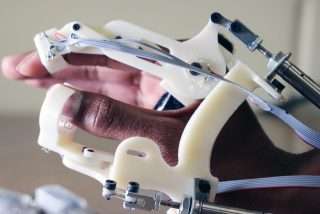Engineer modifies robotic exoskeleton glove to help cerebral palsy diagnosis in children

It's not often a mechanical engineer will tell you the highly complicated piece of diagnostic hardware they are working on needs to appeal to 12- to 36-month-old children to be effective. But, to be fair, it's not often they are designing a robotic exoskeleton to fit on a child's hand.
Pinhas Ben-Tzvi, associate professor of mechanical engineering at Virginia Tech and founding director of the department's robotics and mechatronics lab, has been working with robotic exoskeletons for years and on medical diagnostic robotics systems since his time with General Electric Medical Systems from 2000 to 2002.
When he was called by Nathalie Maitre, a medical doctor at Nationwide Children's Hospital in Columbus, Ohio, to see if his Sensing and Force-Feedback Exoskeleton (SAFE) robotic glove could be modified to help provide an early diagnosis of cerebral palsy in children, he was intrigued.
"Doctor Maitre proposed to fit a modified version of my glove to a child in an effort to apply somatosensory stimuli to measure cortical responses for the early detection of cerebral palsy," Ben-Tzvi said.
The device is currently being developed for adult-sized hands and will be created and tested first at the larger size before being scaled down to fit a child.
"There's a couple of really challenging aspects to this project," said Ben-Tzvi. "The first, of course, is the typical challenge we all face in making something work. But then we have two additional engineering challenges here – to make it much smaller and to make it look child friendly so it doesn't scare the children who have to use it."
The glove as it currently exists, features pneumatically or electrically actuated "fingers" that connect to a wrist-mounted baseplate and via straps to the fingertips. It's far more like something out of "Terminator" than "Doc McStuffins."
The plan for the device is broken into two phases, with the first phase calling for fitting the device on the hands of children 12-36 months old using only a thumb and forefinger to initiate a pincer grasp. The glove would provide tactile feedback. The child would have brain sensors connected to the hospital's Net Station software for electroencephalogram (EEG) acquisition while the robotic device initiates the pincer grasp and acquires finger position and tactile and other data. The EEG records brain wave patterns to detect electrical activity abnormalities in the brain.
In phase two, testing would continue with toddlers to establish baseline values for cortical and sensorimotor responses using 20 children who were developing typically, and five who were diagnosed with cerebral palsy.
"There is a good deal of potential for the device, and it's an interesting application of a product that was mainly intended for hand rehabilitation for stroke victims," Ben-Tzvi said. "I think anytime your work can be modified to help identify a medical issue more quickly, the more beneficial it becomes for the patient and the more options it allows for in treatment. The fact we are taking a device made to deal with after-the-fact issues and using it to possibly help make an earlier diagnosis of an issue is very exciting."
Provided by Virginia Tech





















